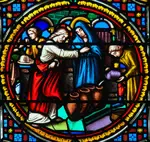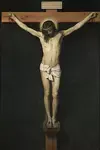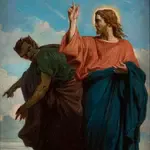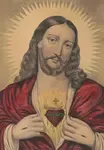A FEW WORDS ABOUT DOUBTING THOMASES
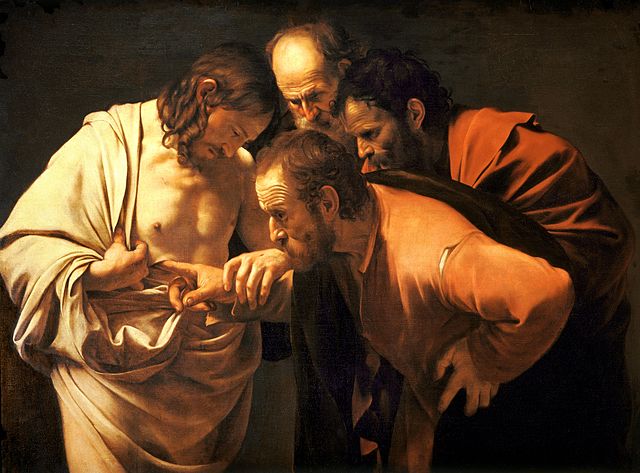
THE FIVE FIRST SATURDAYS IS A DEVOTION NEEDED NOW MORE THAN EVER! FIND OUT MORE HERE
THE SAINT MICHAEL PRAYER AND THE ROSARY
ARE ALSO POWERFUL PRAYERS TO HELP US THROUGH THESE VERY TURBULENT TIMES!
HIGHLY RECOMMENDED! DELIVERANCE PRAYERS,
A BOOK FROM SENSUS TRADITIONIS PRESS
(A GREAT PUBLISHER HELPING US FIGHT OUR MANY SPIRITUAL BATTLES NOWADAYS)!
CHECK OUT OUR PODCAST PAGE AND OUR YOUTUBE CHANNEL FOR INSPIRING CONTENT
THIS WEBPAGE IS ALSO AVAILABLE
AS A PODCAST HERE
Easter is a joyful glorious time indeed when we celebrate Christ’s conquering death in his Resurrection. Among the scripture readings featured in this season is the one where we first read of St. Thomas the Apostle becoming the original Doubting Thomas.
Admittedly, the idea of Jesus’ rising from the dead on the third day after an ignominious death was mystifying to the disciples even though he had told them on three separate occasions (as recorded in both Matthew’s and Luke’s Gospels) during His earthly ministry He would indeed do so.
We also read in Mark’s Gospel, for example, these words expressing apostolic befuddlement following Peter, James and John’s witnessing our Lord’s Transfiguration as he is coming down the mountain with them afterwards:
And as they were coming down the mountain, he charged them to tell no one what they had seen, until the Son of man should have risen from the dead. So they kept the matter to themselves, questioning what the rising from the dead meant. (Mark 9-10)
I can almost see these three great Apostles here. They’ve just witnessed a miracle so striking, complete with their seeing our Lord conversing with Moses and Elijah and even then hearing God the Father’s voice resonating from a cloud in great praise for His Son, that it appears in three of the four Gospels, in Chapter 9 of Mark's and Luke’s Gospels and Chapter 17 of Matthew’s!
Perhaps they said to Jesus when he told them to keep quiet about all this until he was risen from the dead, “Sure, anything you say”, and then walked down the mountain scratching their heads trying to figure out what that actually meant!
The footnotes in the great Ignatius Study Bible shed some further light on this concerning the account above from Mark’s Gospel that “The belief in a collective resurrection was accepted by many Jews during New Testament times…Only the Sadducees expressly denied it….The disciples are here perplexed that Jesus speaks of an individual resurrection, since they as yet had no clear understanding of a dying and rising Messiah”
The disciples' confusion about all this vanished when our Lord appeared before them that first Easter night in the flesh in what was probably the biggest “I told you so!” of all time. Nonetheless we read that the Apostle Thomas was not quite ready to believe in this wondrous miracle, pictured above. The following is taken from the Ignatius Bible, from John’s Gospel (20:24-29)
Now Thomas, one of the Twelve, called the Twin, was not with them when Jesus came. So the other disciples told him, "We have seen the Lord." But he said to them, "Unless I see in his hands the print of the nails, and place my finger in the mark of the nails, and place my hand in his side, I will not believe." Eight days later, his disciples were again in the house, and Thomas was with them. The doors were shut, but Jesus came and stood among them, and said, "Peace be with you." Then he said to Thomas, "Put your finger here, and see my hands; and put out your hand, and place it in my side; do not be faithless, but believing." Thomas answered him, "My Lord and my God!" Jesus said to him, "You have believed because you have seen me. Blessed are those who have not seen and yet believe."
Ah, the original Doubting Thomas! In some ways, his earlier denial did us all a favor. From this Gospel passage Jesus reminds us, not for the first time, that he was not a ghost or a hallucination, but a real walking breathing human being (albeit one with a divine as well as a human nature) whom you could touch and even poke at His wounds!
This wasn’t the only time our Lord’s resurrection met with skepticism by any means! In the book of Acts 17:31 we read about St. Paul telling the Athenians of Christ’s rising from the dead and getting a mixed reaction of curiosity and scorn, as the Athenian notion of death as liberating the soul from the body went against such teachings.
The footnote in the Ignatius Study Bible notes that the resurrection of the dead was “A strange and scandalous notion to Athenian ears. The Greeks believed only in the immortality of the soul; the body, they thought, was a prison from which the soul would be happily liberated at death.”
Sadly there are still many who would deny Jesus’ Resurrection to this day, and not just in other religious faiths. Some Catholics have even been taught that the Resurrection was merely a composite collection of fond memories of Jesus from His earthly ministry by His apostles.
Yet no less a personage than St. Paul underscored the importance of Christ’s Resurrection when he wrote that in his first letter to the Corinthians 15:17, as he put it, "if Christ has not risen vain then is our preaching, vain too is your faith" (1 Cor 15:17).
Nonetheless, our Lord in His great compassion told the Apostles at the Last Supper that he would not leave them orphans, but would send the Holy Spirit to remind them of all that He had taught them (John 14:26). Might I suggest here that likewise He would not leave us without tangible evidence of His Divinity as well in numerous ways.
We might believe as He said without seeing but at the same time He’s given us an abundance of ways that we too might place our fingers in His wounds, figuratively speaking, lest we might be tempted to think of Him as just a holy man but not God.
For starters we have only to consider the doctrine of Transubstantiation as a wondrous reminder that if our Lord could be really present to the disciples after His Resurrection, so can He be really present in a different manner to us today, under the appearance of bread and wine in the Eucharist at Mass! And He is!
You might well ask, as did many when our Lord first made known that his flesh was true food and His blood true drink in the sixth chapter of John’s gospel during His earthly ministry “How can this man give us his flesh to eat”? Is this real? Absolutely!
Blessed Carlo Acutis, a young man who died from leukemia in 2006, gave us an extensive catalogue of what can only be described as Eucharistic miracles including many in which blood emanated from various hosts for Mass on its own, among other wondrous supernatural phenomena in which Jesus reminded us all that He wasn’t just some worldly philosopher or prophet! This webpage for this compendium includes some 151 such accounts from all over the world spanning just about the past 20 centuries!
I would also like to mention here another good resource: Catholic author Joan Carroll Cruz wrote a number of great readable accounts of various incidents that further affirm Christ’s Divinity in a world more and more ready to dismiss anything supernatural about our faith.
These are published by Tan Books and include studies of the supernatural aspects of Christ, His Church and His saints with titles such as Angels and Devils, Eucharistic Miracles, Relics, and Mysteries, Marvels and Miracles in the Lives of the Saints. These books are available as listed here, and no, I’m not getting a commission for this!
One of these books, The Incorruptibles, chronicles those saints such as St. Bernadette Soubirous whose bodies have remained miraculously intact after death, rather than undergoing decomposition as we all normally do when passing from this life!
Speaking of St. Bernadette Soubirous, what made her so famous, or should I say who? Our Blessed Mother Mary who was Jesus’ Mother of course as well. There are numerous church approved apparitions as chronicled here and here of the Blessed Mother appearing to various people, including St. Bernadette in this case, in 1858.
These can and should give cogent arguments against those who would otherwise heap scorn on Mary or insist that believing with supernatural faith in her apparitions or her Divine Son’s miracles was like believing in Santa Claus or the tooth fairy!
So, with all these “proofs” of our Lord’s supernatural existence, keep this in mind: while much valuable scripture commentary covers symbolic aspects of Jesus’ Gospel teaching, (such as His being the vine and we being the branches) remember this: Jesus doesn’t allegorically become present in bread and wine in the Eucharist at the words of Consecration at Mass.
After the Miracle of the Sun in 1917, arranged by our Blessed Mother as Our Lady of Fatima, 70,000 people didn’t allegorically find that their clothes had become completely dry after a soaking rain that preceded this amazing event.
For another good example, there are crutches located at the front of the St. Anne de Beaupre Basilica in Quebec City, Canada which houses the relics of Good St. Anne, our Blessed Mother’s Mother and Jesus’ grandmother! These crutches weren’t allegorically discarded by those who no longer needed them after St. Anne had healed them from their various afflictions over time.
And going back to St. Bernadette for a minute, the waters of the grotto at Lourdes where our Blessed Mother appeared to her haven’t allegorically healed 70 people, as recognized by the church, and upwards of as many as 7000 otherwise as well!
All these things actually have happened, and the bread and wine becoming the body and blood of Jesus at Mass still happens countless times each day all over the world!
Also worth noting here are the accounts of exorcists fighting the devil not in the 1st century but in the 21st! Father Chad Ripperger, Father Gabriel Amorth and Monsignor Stephen Rossetti among others have either books, webpages, and or videos about their struggles, again not allegorically but literally with Satan and all his demonic minions. These evil entities have a red hot or should I say white hot hatred for Jesus and much fear and loathing about our Blessed Mother as well!
While we should never cower in fear at the devil neither should we dismiss him as a mere symbol of evil. St. Padre Pio, who himself endured much demonic abuse in his lifetime, has been quoted as saying nonetheless that “The devil is like a rabid dog tied up to a chain; beyond the length of the chain he cannot seize anyone. And you: keep your distance. If you approach too near, you let yourself be caught. Remember that the devil has only one door by which he enters the soul: the will. There are no secret or hidden doors.”
Likewise St. Peter in a famous quote in scripture advised all of us to “Be sober, be watchful. Your adversary the devil prowls around like a roaring lion, seeking someone to devour. Resist him, firm in your faith” and don’t give into Satan when you endure suffering but rather give our Lord all your troubles and anxieties, as St. Peter put it “for he cares about you.” (1 Pet 5:8-9 and 7)
Tragically, there are many among us these days who would deny our Lord’s supernatural abilities as God while at the same time flirting with occult or pagan practices or worship. Why does this matter? These are all from false Gods. Any pagan deities one may wish to follow instead, much less Satan himself, never can and never will love you. Jesus can and does! He died and was resurrected for humanity as a whole but also just for you!
But Christ said “Thy will be done” to His Heavenly Father and ours, not the Satanic maxim “Do what thou wilt” where the devil tries to entice us to do whatever we please with no thought of any consequences, in this life or certainly not in Eternity. Jesus points the way to selfless giving and loving. Satan, to selfishness and divisiveness, run amok.
The Father of all lies and his demonic minions are all too ready to have you cruise down that Highway to Hell. Once you get there, however, you’ll experience misery forever. In striking contrast God wishes to give you, after a more rocky road carrying your cross with Him at times, an eternity of love in Paradise, for real!
Don’t fall for the empty promises of Satan when he offers you his counterfeit freedom and paradise. He will always hate you because you can have something he and the demons never will: Eternal Life and all the serenity and joy it brings from being with God and being able to bask in the Beatific vision, seeing God face to face in His beauty and peace forever!
St. John put it so well writing about the signs of Christ’s Divinity in his Gospel in Chapter 20 verse 31 that “these are written that you may believe that Jesus is the Christ, the Son of God, and that believing you may have life in his name.” Alleluia!
God Bless,
Christopher Castagnoli
for www.ourcatholicprayers.com
FROM OUR BOOK AND GIFT STORE
OR CAFE PRESS STORE!
Return from Doubting Thomases
to Prayer Blog Page






